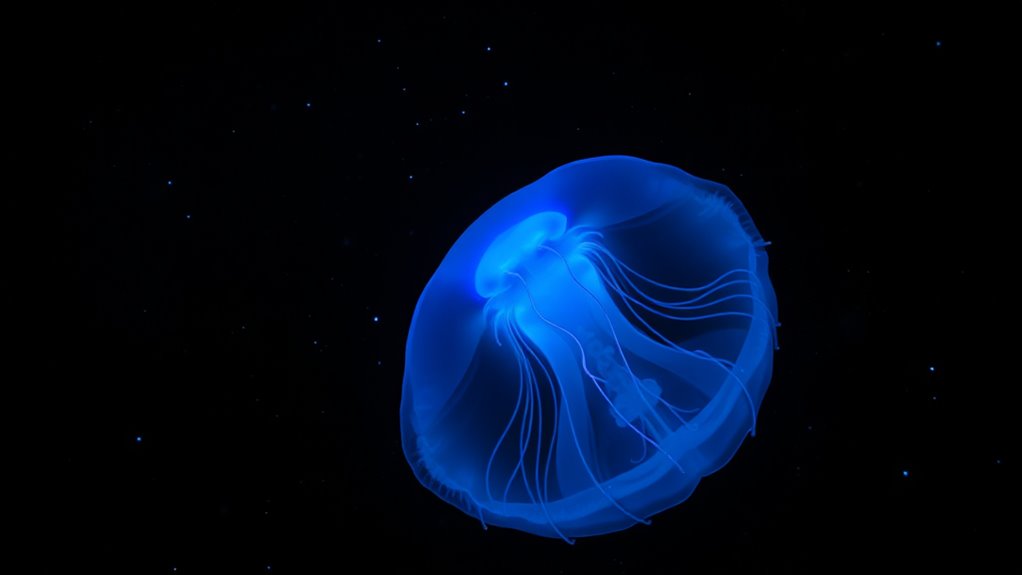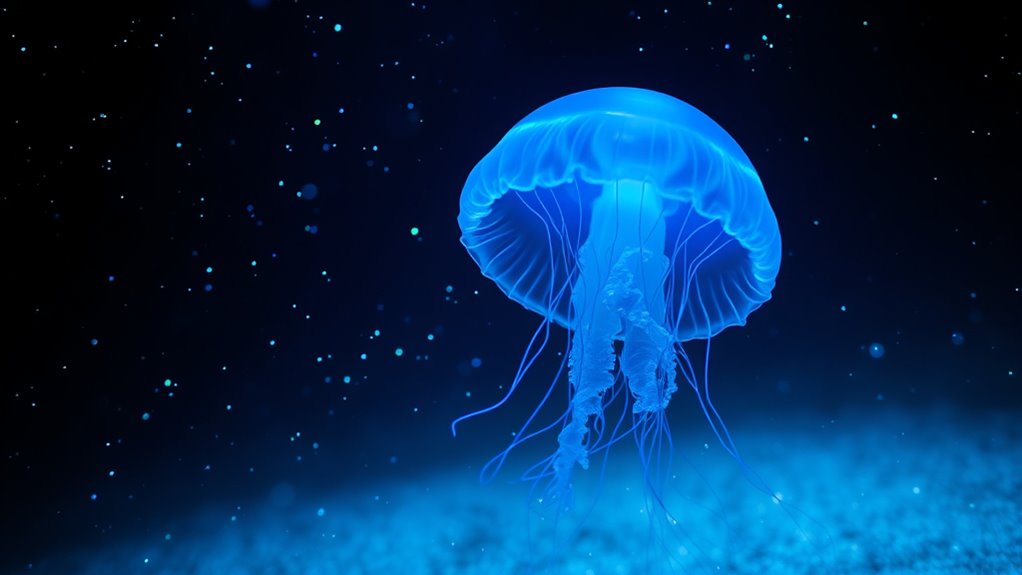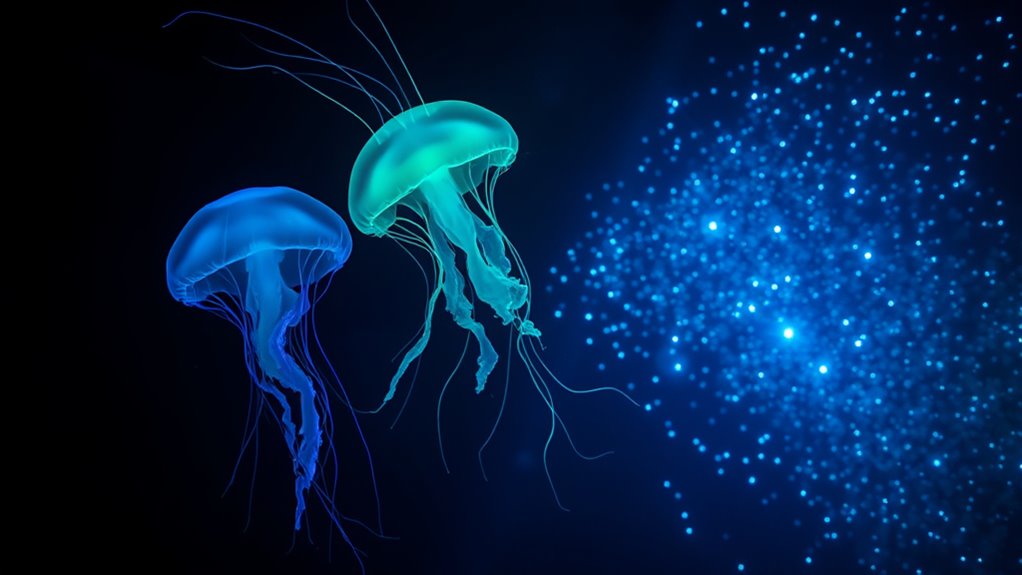Some animals glow in the dark due to a process called bioluminescence. This chemical reaction occurs when luciferin interacts with luciferase, producing light. Species use this glow for various survival strategies, like luring prey, communicating, or deterring predators. For instance, anglerfish use their light to attract food, while some squids blend in with their surroundings. The fascinating world of glowing creatures offers even more surprises, and there's much more to uncover about their unique adaptations.
Key Takeaways
- Bioluminescence helps organisms communicate, attract mates, or signal danger to deter predators.
- Many animals use glowing features for camouflage, blending into their surroundings to avoid detection.
- Some species, like anglerfish, employ bioluminescent lures to attract and capture prey.
- Certain deep-sea creatures emit light to confuse predators, facilitating their escape.
- Bioluminescence can indicate toxicity, warning potential predators to stay away from harmful species.
Understanding Bioluminescence

Bioluminescence is a fascinating natural phenomenon that occurs when living organisms emit light through a chemical reaction involving substances like luciferin and luciferase.
You'll find that many bioluminescent animals, particularly in the ocean, produce this cold light with minimal heat. About 76% of ocean creatures, including over 1,500 fish species, display this ability, primarily emitting blue-green light, which fits perfectly within the visible light spectrum for deep-sea environments.
The ecological significance of bioluminescence is immense, as it fosters symbiotic relationships, enabling communication and predation. Some species use their glow to confuse predators or attract mates, while others can shed glowing body parts to distract threats, showcasing the diverse adaptations that enhance survival in their ecosystems.
The Role of Bioluminescence in Survival

While many organisms rely on camouflage or speed to evade predators, bioluminescence offers a unique survival advantage that enhances their chances of survival. In the deep sea, bioluminescent light serves as both a defense mechanism and a tool for predation.
Bioluminescence provides deep-sea creatures with innovative strategies for evading predators and capturing prey, significantly boosting their survival rates.
For instance, species like the anglerfish use their glow to lure unsuspecting prey. Meanwhile, deep-sea shrimp can "vomit" light, blinding predators and facilitating their escape.
Some creatures, such as the Southern Bobtail Squid, employ counterillumination, adjusting their light intensity to blend seamlessly into their surroundings, providing effective camouflage.
Additionally, bioluminescence can signal toxicity, deterring curious predators. By using these strategies, bioluminescent animals increase their survival odds in a challenging environment.
Examples of Bioluminescent Animals

The ocean is home to a fascinating array of bioluminescent animals, each showcasing unique adaptations that enhance their survival. For instance, the Hawaiian bobtail squid forms a symbiotic relationship with bioluminescent bacteria, allowing it to blend in with moonlit waters.
In the deep sea, the American pocket shark emits bioluminescent fluid to attract prey, while deep-sea anglerfish use their glowing lure to entice unsuspecting victims. Curiously, about 76% of marine species use some form of bioluminescence, including jellyfish and sharks.
On land, fireflies produce light in their abdomens for mating signals, with various species flashing distinct patterns to attract partners. These glowing adaptations highlight the incredible diversity of life on our planet.
The Science Behind the Glow

To understand how animals glow in the dark, you need to look at the chemical reactions behind bioluminescence.
This fascinating process often involves luciferin and luciferase, creating light through a unique reaction.
You'll see that different types of bioluminescence serve various purposes, from attracting mates to warding off predators.
Chemical Reactions Explained
Understanding the science behind bioluminescence reveals a fascinating world of chemical reactions that produce light in various organisms. At the core of this phenomenon is luciferin, a light-emitting molecule that, when combined with luciferase or photoproteins, undergoes a chemical reaction to generate light without heat. The resulting glow varies in color, primarily due to the structure of luciferin and its interaction with oxygen. This process can occur continuously or intermittently, depending on the organism's needs.
| Component | Function | Byproduct |
|---|---|---|
| Luciferin | Light-emitting molecule | Oxyluciferin |
| Luciferase | Catalyzes the reaction | None |
| Oxygen | Reacts with luciferin | Necessary for light |
| Bioluminescent | Organisms that emit light | N/A |
| Chemical Reaction | Process producing light | N/A |
Types of Bioluminescence
While exploring the diverse world of bioluminescence, you'll find that it can be categorized into two primary types: those that rely on luciferin and luciferase, and those that utilize photoproteins.
In the first type, organisms produce a chemical reaction involving luciferin, which emits cold light when combined with luciferase, generating minimal thermal radiation. The second type uses photoproteins that require calcium ions to emit light without the need for luciferase.
Most bioluminescent organisms, particularly in marine environments, emit blue-green light, as it falls within the visible spectrum and is the most effective underwater.
This fascinating adaptation serves various ecological roles, from attracting mates to luring prey, showcasing the incredible diversity of bioluminescent life.
Biofluorescence: A Different Kind of Glow

Biofluorescence is a fascinating process where animals absorb UV light and re-emit it as visible light, creating a unique glow.
You might be surprised to learn that species like flying squirrels and platypuses showcase this remarkable ability.
Understanding the mechanisms, examples, and ecological significance of biofluorescence can reveal intriguing insights into the lives of these glowing creatures.
Mechanisms of Biofluorescence
When you observe animals glowing under ultraviolet light, you're witnessing the fascinating process of biofluorescence. This unique phenomenon occurs when an organism absorbs UV light and then emits light at a different, visible wavelength.
Here's what makes biofluorescence enchanting:
- Color Variability: The glow can range from vibrant greens to deep reds.
- Species Diversity: It's found in various animals, including flying squirrels and Gouldian Finch chicks.
- Functional Benefits: It enhances visibility for mating or feeding.
- Chemical Components: Porphyrins in fur can contribute to the glow.
- Ongoing Discovery: Research reveals more species exhibiting this trait than previously known.
Biofluorescence showcases nature's complexity, making the animal kingdom even more intriguing.
Examples of Fluorescent Animals
The world of biofluorescent animals is filled with remarkable examples that highlight this enchanting phenomenon. For instance, the Hawksbill Turtle and various corals glow vividly under ultraviolet light, showcasing their biofluorescent traits.
Australian mammals, like the platypus and wombat, also join the ranks, emitting a bright glow when exposed to UV illumination.
Even birds contribute to this spectacle; the Gouldian Finch's chicks have fluorescent beads that help their parents find them for feeding.
Additionally, Argentinean frogs and Virginia Opossums exhibit biofluorescence, suggesting that many animals use this fascinating ability.
These examples reveal the intriguing ways biofluorescence manifests across diverse species, making the natural world even more captivating.
Ecological Significance of Glow
Glow in the dark creatures wield a unique advantage in their ecosystems, thanks to biofluorescence. This intriguing phenomenon offers several ecological functions that enhance survival:
- Camouflage: Their glow blends with ambient light, making them harder to detect.
- Communication: Biofluorescent patterns can signal to mates or rivals in low-light settings.
- Health signaling: A bright glow may indicate liveliness, attracting potential mates.
- Predator avoidance: Some species use their glow to confuse or deter predators.
- Nutrient detoxification: Ongoing research suggests biofluorescence may help in processing harmful dietary substances.
These functions illustrate how biofluorescence isn't just an enthralling spectacle; it plays an essential role in the survival and interaction of various species within their environments.
Ongoing Research and Discoveries in Bioluminescence

Although bioluminescence has fascinated scientists for years, ongoing research is revealing even more about the incredible diversity and functions of glowing organisms in our oceans.
You'll discover that 76% of ocean animals exhibit bioluminescence, including bioluminescent plankton, which can emit different wavelengths of light, even red. Researchers are investigating the ecological roles this phenomenon plays, such as predation, communication, and camouflage.
Recent studies have also uncovered biofluorescence in mammals like flying squirrels and wombats, indicating its broader presence in the animal kingdom.
Recent findings reveal that biofluorescence exists in mammals, including flying squirrels and wombats, highlighting its expanding role in the animal kingdom.
Furthermore, scientists explore bioluminescence's potential in biotechnology, like using green fluorescent protein (GFP) for tracking gene activity or developing bioluminescent crops, enhancing agricultural monitoring and sustainability efforts.
Exciting discoveries continue to emerge!
Frequently Asked Questions
Why Do Animals' Eyes Glow in the Dark but Not Humans?
Animals' eyes glow in the dark because they've a special layer called the tapetum lucidum behind their retinas.
This layer reflects light, enhancing their night vision and making their eyes appear to glow in low light.
You don't have this adaptation, which is why your eyes don't glow at night.
While you can see well in dim light thanks to your rod cells, you lack that reflective layer animals possess.
How Are Some Animals Bioluminescent?
Did you know that about 76% of ocean animals can glow in the dark?
Some animals are bioluminescent because they produce light through a chemical reaction involving luciferin and luciferase. This process creates a cold light, allowing creatures like anglerfish to attract prey or deep-sea shrimp to evade predators.
The stunning blue-green glow you see underwater serves essential survival purposes, highlighting nature's incredible adaptations in the dark depths of the ocean.
Why Do Some Mammals Glow Under UV Light?
Some mammals glow under UV light due to biofluorescence, a process where they absorb ultraviolet light and re-emit it as visible light.
This trait likely offers advantages like camouflage, communication, or detoxifying harmful substances. Their glowing fur results from porphyrins, which fluoresce when exposed to UV.
Researchers are exploring whether these mammals can see each other's glow, potentially influencing their social interactions and mating behaviors in the wild.
Is Bioluminescence Good or Bad?
Bioluminescence can be both good and bad, depending on the context.
You'll see it providing predators with an advantage, luring prey closer, which enhances survival. On the flip side, it can also signal danger to potential predators, indicating toxicity.
Some organisms use their glow for mating, promoting reproduction. However, it can disrupt ecosystems by attracting unintended prey or predators, creating imbalances in food webs.
Conclusion
So, next time you're out in the dark and see a glowing critter, don't just marvel at its beauty—ask yourself why you're not glowing too! While these bioluminescent marvels light up the night, you're left fumbling for your flashlight. Maybe it's time to demand a glow-up of your own! After all, if nature can throw a party with glowing animals, shouldn't you at least get a glow stick or two? Let's get luminous!










